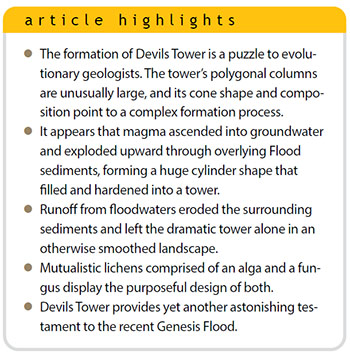 Many people have seen pictures of Devils Tower or visited the site in Wyoming. Very few of the 500,000 annual visitors, though, may understand the mystery of its formation or the distinct role the global Flood played in its development.
Many people have seen pictures of Devils Tower or visited the site in Wyoming. Very few of the 500,000 annual visitors, though, may understand the mystery of its formation or the distinct role the global Flood played in its development.
Army Lt. Col. Richard Dodge assigned the tower’s name while leading a military expedition into the region in 1875. In 1906, President Theodore Roosevelt established Devils Tower as America’s first national monument. Located in northeastern Wyoming about 100 miles west of Rapid City, South Dakota, the 1,000-plus-acre monument draws curious travelers driving between Yellowstone and the Black Hills, as well as 5,000 to 6,000 rock climbers each year.
The mystery of its formation begins with its general cone shape and a unique fracture pattern known as columnar jointing. Many lavas form hexagon-shaped columns as they cool, but none are as large as the column widths (10 feet) at Devils Tower, or as tall. The National Park Service reports, “Devils Tower is 867 feet from its base to the summit. It stands 1,267 feet above the Belle Fourche River and is 5,112 feet above sea level.”1
Cooling Magma Columns
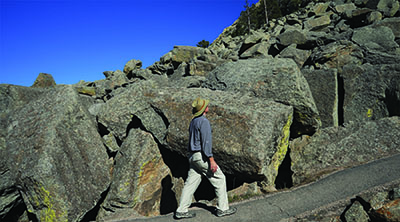
Evolutionary geologists are still uncertain how Devils Tower formed, but they assert it happened 50 million years ago. Made of a rock called phonolite, it has a greenish-gray color.2 Early interpreters deduced it was the core of an ancient volcano. Others believed it to be a laccolith, a large magma that squeezes into overlying sedimentary rocks and bows the sediments upward into a mushroom shape.3 But we see no evidence that the surrounding sediments were bent upward. They remain flat, layer after layer, just the way they were deposited in the Flood.
Prokop Závada and his colleagues formulated the latest idea concerning the tower’s formation. They proposed the tower was a maar-diatreme volcano.3,4 This is a special volcanic feature that forms when magma encounters groundwater, which becomes superheated and then explodes to the surface, puncturing the overlying sediments. The new hole fills with rising magma to create a cylinder-shaped underground lava tower.4 Soon after Devils Tower was formed, draining floodwaters eroded the surrounding sediment layers and left the lava monolith behind.
This process would only work with freshly deposited sediments that were still uncemented. Similar superheated water at Yellowstone doesn’t blow out a big hole since the rocks above are already hardened. So, if the tower did form as a maar-diatreme, only the conditions of the Flood could have allowed its development.
Columns from Cooling
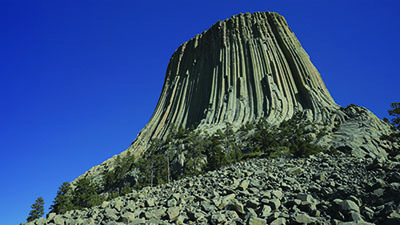
What about those massive polygonal columns? Devils Tower is again unique in that it has many pentagon-shaped columns. Studies suggest all of these columns cool from the top, with contraction forming regularly spaced fractures that propagate downward. During the Flood, groundwater percolating along the open fractures likely caused the lower part of the magma to cool quickly. Fast cooling makes less orderly fracture patterns.5 We see this at the base of the tower where the columns become chaotic and disorganized.
Magmas similar in age to Devils Tower also intruded into the surrounding region.6 ICR scientists determined that these magmas formed during the receding phase of the Flood after most of the sediments were deposited.7
Rapid Landscape Erosion
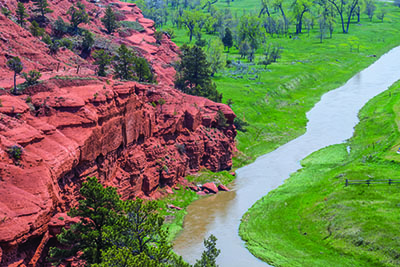
Devils Tower stands alone above the surrounding landscape. Signage at Devils Tower claims that a “mighty current millions of years ago” from the nearby Belle Fourche River swept away the sediments. But rivers are too small to sweep away an entire landscape and leave it so uniformly level. Rivers instead follow confined channels and don’t erode vast terrains. What was the source of this vast “current”?
The best explanation is that all of the sediments that once covered the magma intrusion were eroded during the final recession of the Flood. These missing strata included layers deposited in the Zuni Megasequence, a vast package of rock layers found on every continent. ICR research has shown that the Zuni was deposited when floodwater completely covered the earth.8 Some of these eroded strata included the dinosaur-rich Morrison Formation, where ICR’s team of scientists found bones from Allosaurus and Camarasaurus a few miles south of Devils Tower.9
Why Devils Tower Is Young
The Flood’s receding phase preserved the phonolite monolith because igneous rocks are more resistant than wet, uncemented sediments. However, because the columns are so uniformly fractured, they erode more rapidly than most igneous rocks. Vast temperature changes, rain, and snowmelt cause the columns to break free and fall. The base of Devils Tower is piled with broken columns up to 150 feet deep.
But if Devils Tower was exposed 5 to 10 million years ago, as conventional scientists claim, it probably would have completely eroded away in this amount of time. At the very least, it should be entirely buried in its own debris of broken columns. And the Belle Fourche River doesn’t seem to be eroding away any broken columns since none are found within its waterway. The relatively thin buildup of broken columns at the tower’s base fits its recent exposure 4,500 years ago during the draining of the floodwaters.
Lichens: Engineered Partnerships
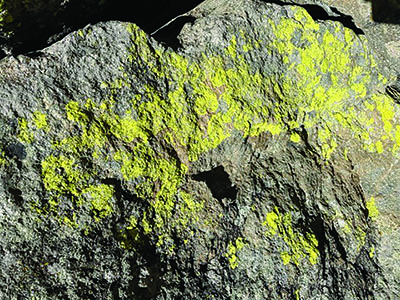
The phonolite columns of Devils Tower and the boulder debris surrounding it are encrusted with a phenomenon that exemplifies a uniquely designed living collaboration—lichens. These systems comprise a mutualistic combination of two individuals, a photosynthetic alga (photobiont) and a fungus (mycobiont).10 The fungal species provides structure, moisture, and protection for the alga, which in turn harnesses light energy from the sun to produce food for itself and its host fungus. Neither organism can flourish without the other, pointing to unmistakable evidence of purpose in biological engineering. Together, the two organisms acquire an integrated set of adaptable properties that differ from those of each respective entity.
The most visible lichen covering these rocks is a yellow-green crustose form known as Acarospora sp. Ecologically, this mutualist produces acids that break down solids and minerals, contributing to the weathering of rocks and other objects upon which the lichen grows. It reproduces by fragmentation, growing outward, or by sending buds and spores into the wind. Available substrates in the area have become a “canvas” of lichen colonization. Additionally, lichens can survive on very low water content with very slow rates of growth (0.04 to 0.4 inches per year). Some lichens may be 4,500 years old, dating back to the immediate post-Flood period.11
Yet, the lichen is not thriving in isolation. As it weathers the rocks, it alters their surfaces, aiding in the settlement and colonization of other lichens, including foliose (“leafy”) and fruticose (“shrubby”) forms.10 In turn, these engineering marvels invite vine-like foliage growth or the attachment and germination of seeds that enable trees to take root upon the vertical rock faces of the Devils Tower columns. We shouldn’t be surprised by this because if we look closely, we’ll recognize even more signatures of the wise and thoughtful hand of our Creator Jesus Christ.
The Flood Explains the Mystery
Devils Tower stands as a monument to the Flood, whose conditions laid the foundation for its catastrophic development. Groundwater within the recently deposited Flood sediments likely became superheated by the intruding magma, which then exploded and created a hole that a tower of magma filled. As the molten material began to cool, additional groundwater seeped down the column fractures, causing rapid cooling of the remaining magma.
Erosion during the receding stage of the Flood swept away the covering Flood sediments, leaving the subdued landscape that surrounds the tower. The thin pile of columns at the tower’s base demonstrate that Devils Tower has been exposed for only thousands of years. Now lichen, marvels of God’s design, work in engineered harmony to thrive and help break down these exposed rocks.
With Genesis in hand, the mystery of Devils Tower’s formation can be solved.
References
- Frequently Asked Questions. Devils Tower National Monument Wyoming. National Park Service. U.S. Department of Interior. Posted on nps.gov/deto, updated October 26, 2020.
- Devils Tower is made of phonolite porphyry, an unusual type of extrusive igneous rock that’s low in quartz and has white feldspar crystals. Porphyry indicates the rock had a complex cooling history. The large, visible minerals it contains presumably crystallized deep in the earth. The surrounding finer-grained crystals (the matrix) cooled more rapidly near the surface after it was emplaced.
- How the Tower Formed. Devils Tower National Monument Wyoming. National Park Service. U.S. Department of Interior. Posted on nps.gov/deto, updated December 5, 2019.
- Závada, P. et al. 2015. Devils Tower (Wyoming, USA): A lava coulée emplaced into a maardiatreme volcano? Geosphere. 11 (2): 354-375.
- Clarey, T. 2022. Entablature Reveals Flooding of Columbia River Basalts. Acts & Facts. 51 (7): 7.
- We can date the relative time of these intrusions elsewhere by the layers they penetrate. Any intrusion had to occur after the overlying layers were deposited.
- Clarey, T. 2019. Black Hills Sites Showcase Creation and the Flood. Acts & Facts. 48 (9): 5-7.
- Clarey, T. 2020. Carved in Stone: Geological Evidence of the Worldwide Flood. Dallas, TX: Institute for Creation Research.
- Thomas, B. 2021. ICR’s First Dinosaur Excavation. Acts & Facts. 50 (12): 7.
- Raven, P. H. et al. 1999. Biology of Plants, 6th ed. New York: W. H. Freeman & Company.
- Tomkins, J. P. 2020. Symbiotic Lichens Showcase Our Creator’s Ingenuity. Acts & Facts. 49 (2): 15.
*Dr. Clarey is Director of Research at the Institute for Creation Research and earned his Ph.D. in geology from Western Michigan University.





















